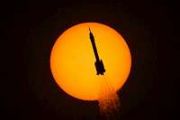
Copernical Team
Hughes awarded IDIQ Contract by U.S. Air Force to offer enterprise satellite networking solutions
 Hughes Network Systems has been awarded one of several prime positions on an indefinite-delivery/indefinite-quantity (IDIQ) contract with a ceiling of $950,000,000 by the U.S. Air Force to support its Advanced Battle Management System (ABMS). Hughes will offer flexible satellite communications solutions that leverage open systems design, modern software and algorithm development in order to enab
Hughes Network Systems has been awarded one of several prime positions on an indefinite-delivery/indefinite-quantity (IDIQ) contract with a ceiling of $950,000,000 by the U.S. Air Force to support its Advanced Battle Management System (ABMS). Hughes will offer flexible satellite communications solutions that leverage open systems design, modern software and algorithm development in order to enab Raytheon Intelligence and Space completes Next Gen OPIR Block 0 Milestone
 Raytheon Intelligence and Space, a Raytheon Technologies business, completed a Critical Design Review of its competitive sensor payload design for the U.S. Space Force's Next-Generation Overhead Persistent Infrared or Next-Gen OPIR, Block 0 GEO missile warning satellites, which are being designed and built by spacecraft prime contractor Lockheed Martin.
"Protecting the U.S. and our allies
Raytheon Intelligence and Space, a Raytheon Technologies business, completed a Critical Design Review of its competitive sensor payload design for the U.S. Space Force's Next-Generation Overhead Persistent Infrared or Next-Gen OPIR, Block 0 GEO missile warning satellites, which are being designed and built by spacecraft prime contractor Lockheed Martin.
"Protecting the U.S. and our allies Northrop Grumman demonstrates open architecture high-speed connectivity
 Northrop Grumman Corporation has validated the open architecture nature of its advanced gateway system offering by successfully integrating and demonstrating a new High Capacity Backbone (HCB) capability provided by L3Harris Technologies with one of Northrop Grumman's platform agnostic gateway systems. By combining existing gateway translations across existing data links and AI enhanced networki
Northrop Grumman Corporation has validated the open architecture nature of its advanced gateway system offering by successfully integrating and demonstrating a new High Capacity Backbone (HCB) capability provided by L3Harris Technologies with one of Northrop Grumman's platform agnostic gateway systems. By combining existing gateway translations across existing data links and AI enhanced networki Phantom Space acquires Micro Aerospace Solutions
 Phantom Space Corporation has reported the successful acquisition of Micro Aerospace Solutions, a leader in space communications systems, space propulsion systems, and electrical hardware design for spacecraft and rockets. The acquisition has further propelled Phantom towards its goal of democratizing space access by mass manufacturing launch vehicles, satellites, and space propulsion systems. T
Phantom Space Corporation has reported the successful acquisition of Micro Aerospace Solutions, a leader in space communications systems, space propulsion systems, and electrical hardware design for spacecraft and rockets. The acquisition has further propelled Phantom towards its goal of democratizing space access by mass manufacturing launch vehicles, satellites, and space propulsion systems. T Delivery partner sought to inspire the next generation of space enthusiasts
 As we work towards establishing commercial vertical and horizontal small satellite launches from UK spaceports from 2022, the UK Space Agency is undertaking a programme of educational activity to inspire young people, particularly those from under-represented groups, to engage with STEAM (Science, Technology, Engineering, Art and Maths) subjects. We hope to inspire the next generation of British
As we work towards establishing commercial vertical and horizontal small satellite launches from UK spaceports from 2022, the UK Space Agency is undertaking a programme of educational activity to inspire young people, particularly those from under-represented groups, to engage with STEAM (Science, Technology, Engineering, Art and Maths) subjects. We hope to inspire the next generation of British Most detailed-ever images of galaxies revealed using LOFAR
 The universe is awash with electromagnetic radiation, of which visible light comprises just the tiniest slice. From short-wavelength gamma rays and X-rays, to long-wavelength microwave and radio waves, each part of the light spectrum reveals something unique about the universe.
The LOFAR network captures images at FM radio frequencies that, unlike shorter wavelength sources like visible li
The universe is awash with electromagnetic radiation, of which visible light comprises just the tiniest slice. From short-wavelength gamma rays and X-rays, to long-wavelength microwave and radio waves, each part of the light spectrum reveals something unique about the universe.
The LOFAR network captures images at FM radio frequencies that, unlike shorter wavelength sources like visible li Astronomers find a 'break' in one of the Milky Way's spiral arms
 Scientists have spotted a previously unrecognized feature of our Milky Way galaxy: A contingent of young stars and star-forming gas clouds is sticking out of one of the Milky Way's spiral arms like a splinter poking out from a plank of wood. Stretching some 3,000 light-years, this is the first major structure identified with an orientation so dramatically different than the arm's.
Astronom
Scientists have spotted a previously unrecognized feature of our Milky Way galaxy: A contingent of young stars and star-forming gas clouds is sticking out of one of the Milky Way's spiral arms like a splinter poking out from a plank of wood. Stretching some 3,000 light-years, this is the first major structure identified with an orientation so dramatically different than the arm's.
Astronom Celestial Sleuth corrects historical record on Gegenschein discovery
 The discovery of the gegenschein-a faint nighttime glow that appears as a diffuse brightening at the anti-sun, the point in the sky exactly opposite the sun-has usually been attributed to French Jesuit astronomer Esprit Pezenas in 1730.
Now, Texas State University astronomer, physics professor emeritus and Texas State University System Regents' Professor Donald Olson has applied his distin
The discovery of the gegenschein-a faint nighttime glow that appears as a diffuse brightening at the anti-sun, the point in the sky exactly opposite the sun-has usually been attributed to French Jesuit astronomer Esprit Pezenas in 1730.
Now, Texas State University astronomer, physics professor emeritus and Texas State University System Regents' Professor Donald Olson has applied his distin Saturn makes waves in its own rings
 In the same way that earthquakes cause our planet to rumble, oscillations in the interior of Saturn make the gas giant jiggle around ever so slightly. Those motions, in turn, cause ripples in Saturn's rings.
In a new study accepted in the journal Nature Astronomy, two Caltech astronomers have analyzed those rippling rings to reveal new information about the core of Saturn. For their study,
In the same way that earthquakes cause our planet to rumble, oscillations in the interior of Saturn make the gas giant jiggle around ever so slightly. Those motions, in turn, cause ripples in Saturn's rings.
In a new study accepted in the journal Nature Astronomy, two Caltech astronomers have analyzed those rippling rings to reveal new information about the core of Saturn. For their study, NASA's Ingenuity helicopter completes 12th Mars flight
 NASA's Ingenuity helicopter completed its 12th flight on Mars, officials said early Tuesday, as it scouts out the Martian terrain for the Perseverance land rover.
The 4-pound autonomous aircraft flew over the South Seitah region of the Red Planet, traveling a total of 1,476 feet round trip at a height of nearly 33 feet for 169 seconds, NASA's Jet Propulsion Laboratory said via Twitter.
NASA's Ingenuity helicopter completed its 12th flight on Mars, officials said early Tuesday, as it scouts out the Martian terrain for the Perseverance land rover.
The 4-pound autonomous aircraft flew over the South Seitah region of the Red Planet, traveling a total of 1,476 feet round trip at a height of nearly 33 feet for 169 seconds, NASA's Jet Propulsion Laboratory said via Twitter. 
































